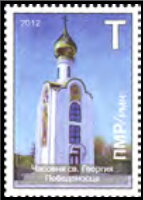Stamp: Chapel of St. George the Victorious (Transnistria 2012)
Chapel of St. George the Victorious (Transnistria 2012)
14 October (Transnistria ) within release Memorials of Memory of Transnistria goes into circulation Stamp Chapel of St. George the Victorious face value T No Face Value
| Stamp Chapel of St. George the Victorious in catalogues | |
|---|---|
| Colnect codes: | Col: MD-PMR 2012.10.14-04 |
Stamp is square format.
Issued in sheets of 10 (5 x 2) stamps - 8 memorial stamps and 1 each coat of arms and flag stamps.Also in the issue Memorials of Memory of Transnistria:
- Stamp - Chapel of St. George the Victorious face value T;
- Full Pane - Chapel of St. George the Victorious face value 10*T;
- Souvenir Sheet - Eternal Memory of the Valiantly Fallen face value 7*T;
- Stamp - Memorial of Glory - Wall of Memory face value T;
- Full Pane - Memorial of Glory - Wall of Memory face value 10*T;
- Stamp - Memorial of Memory and Sorrow face value T;
- Full Pane - Memorial of Memory and Sorrow face value 10*T;
- Stamp - Monument to the 55th Podolsk Infantry Regiment face value T;
- Full Pane - Monument to the 55th Podolsk Infantry Regiment face value 10*T;
- Stamp - Monument to the Cossack Arrow face value T;
- Full Pane - Monument to the Cossack Arrow face value 10*T;
- Stamp - State Coat of Arms of PMR face value T;
- Stamp - State Flag of PMR face value T;
Stamp Chapel of St. George the Victorious it reflects the thematic directions:
A church building, often simply called a church, is a building used for Christian religious activities, particularly worship services. The term in its architectural sense is most often used by Christians to refer to their religious buildings, but it is sometimes used (by analogy) for buildings of other religions. In traditional Christian architecture, the church is often arranged in the shape of a Christian cross. When viewed from plan view the longest part of a cross is represented by the aisle and the junction of the cross is located at the altar area. Towers or domes are often added with the intention of directing the eye of the viewer towards the heavens and inspiring church visitors. Modern church buildings have a variety of architectural styles and layouts; many buildings that were designed for other purposes have now been converted for church use; and, similarly, many original church buildings have been put to other uses. The earliest identified Christian church was a house church founded between 233 and 256. During the 11th through 14th centuries, a wave of building of cathedrals and smaller parish churches occurred across Western Europe. A cathedral is a church, usually Roman Catholic, Anglican, Oriental Orthodox or Eastern Orthodox, housing the seat of a bishop.
A monument is a type of structure that was explicitly created to commemorate a person or event, or which has become relevant to a social group as a part of their remembrance of historic times or cultural heritage, due to its artistic, historical, political, technical or architectural importance. Examples of monuments include statues, (war) memorials, historical buildings, archaeological sites, and cultural assets. If there is a public interest in its preservation, a monument can for example be listed as a UNESCO World Heritage Site. The Palgrave Encyclopedia of Cultural Heritage and Conflict gives the next definition of monument:


